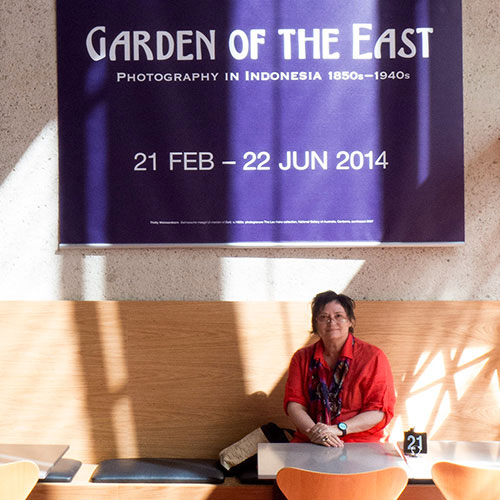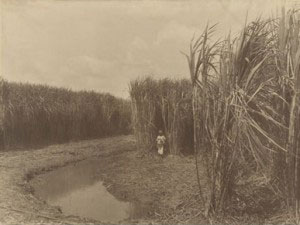Interview with Gael Newton
Lynette Letic, April 2014
With a career spanning more than 40 years, Gael Newton is currently the Senior Curator of Photography at the National Gallery of Australia. She has curated numerous exhibitions and published writings on the history of Australian photography, as well as artist monographs for names including Max Dupain, Tracey Moffatt and John Kauffmann.
Lynette Letic interviews Gael in regards to her role at the National Gallery of Australia, the latest exhibition at NGA and her background in the arts.

Where did you complete your art education and how did it lead into a career in the arts?
I started in Sydney at the University of Arts in 1969 and finished in Auckland University 1972. I was in the first intake of the Power Department of Fine Art students in 1969. In second year I found I was making a lot of art at home and I wondered if I should have gone to art school. So I cross credited to Elam Art School part of Auckland University as they had a Bachelor of Fine Art, while Australia only had a Diploma of Fine Arts and I thought the diploma would be useless unless you were really successful as an artist. Photography was mandatory in first year at Elam and I liked the department staff.
I knew I was a crap artist within a few weeks but loved the art school it was as close to the Bauhaus zeitgeist as you’d get in the late 20th century.
We had to continue with art history at the university under the BFA and I got more involved with that aspect. I graduated in 1974, enrolled for a Masters and practised for a bit as a photographer (hilarious failure), came to Sydney for a wedding and hoped to get a job at the new Australian Centre for Photography, never went back to New Zealand as old Sydney University people kept getting me jobs including at the Art Gallery of New South Wales in the education office. I sort of knew what a curator was but didn’t know it was a career. Anne Kirker had been at the Auckland Library and let students look at the old prints one afternoon a week as I recall (it would never happen now).
Once in the door at AGNSW I knew immediately that art museum curatorship was perfect for me. It was art history plus art works and artists. Academia didn’t appeal, as it didn’t seem to have enough actual contact with art works or artists.
What initially interested you in photography and how did you decide to specialise in the medium? |
 |
Unknown photographer
Working Bali 1930s
I Goesti Agoeng Bagoes Djelantik,
Anakagoeng Agoeng Negara, Karang Asem Bali 1931
gelatin silver photograph 14.0 x 9.7 cm
Collection National Gallery of Australia |
Complete surprise, I never took any photos as a kid, and photo history was not part of Power Department courses so now I realise I liked it because it was representational, it was an art still with its feet in the mud of daily life, it was about stuff. And photos are just hypnotically wonderful. I am still amazed that such art and intelligence can operate under the curious conditions of camera operation whether on the run or in the studio. It defies logic.
What does your role as Senior Curator of Photography involve?
Driving an acquisition program against a set of policy parameters (which can be viewed here and here).
A friend once observed that a curators’ job was to disappoint most artists most of the time and that was sobering, but had a grain of truth. It’s great though seeing work you have brought into the collection on the walls, preparing/researching exhibitions and contributing too, to shows across all mediums in the collection, checking loan valuations, responding to emails, answering inquiries, writing articles, entries, delivering various public programs, talks, collection management projects. All the research/writing gets done at home. Museum courses don’t really account for the public speaking/writing aspect of curatorship but it’s a big part. Our Curator of photography Anne O Hehir has increasingly taken over collection displays, photospace exhibits and loans as well as many public talks and visitors.
Have you worked on projects internationally as well as within Australia?
Not as much as I would have liked; I’ve taken a few shows overseas in my time but I worked quite a lot on the Routledge Encyclopaedia of Nineteenth Century Photography (2007). I did various entries national surveys of South East Asian photography, zoological photography, and assisted editor John Hannavy.
The Garden of the East: photography in Indonesia 1850s-1940s exhibition opened in late February to acclaim. What was the process behind curating this particular show and how did you source the featured material?
I’ve been working on Asia-Pacific photo history since 2006, the same year we bought the private collection assembled by Amsterdam rare book and print dealer Leo Haks, which he had assembled from 1977. It was his personal passion being an amateur photographer as well, and I have added to the thousands of images in it by another few hundred! I’ve worked on the Garden exhibition extensively for the last two years. |
 |
Gael Newton in the NGA Restaurant, February 2014
Photographer: Paul Costigan
|
There were thousands of prints and while quite a bit of information was available in English as many Dutch publications have English parallel texts, it was a matter of finding our own path through it and looking at the material from a perspective based within our region not some view of the periphery of the world from a Eurocentric position. I think I did put emphasis elsewhere than the standard histories and highlighted a few photographers that seemed neglected and I tried to highlight Australian and Indonesian scholars.
How have you seen the evolution of Australian photography expand and shift over the past decade?
Well the biggest change was when art photographers started being exhibited alongside contemporary art and that I date quite specifically to Bernice Murphy’s first Perspecta exhibition at the Art Gallery of New South Wales in 1981. There had been a division before of artists who used photography and “photographers” who were seen as nice in their own way but not serious ‘contemporary art’.
Over the last decade black and white work is disappearing in contemporary work and seemingly losing a bit of a following among audiences who have only known large colour as the dominant norm in their lives since the 1990s. (One collector was quite puzzled at seeing small and black and white 1970s photographs and wondered why the artist had done them like that instead of in colour). The big changes have been the centrality photomedia has in contemporary art, the increased art market value of Australian vintage prints, the rise of video as a high end collectable and ditto its centrality in contemporary art after decades of being dubbed ‘experimental new media’ and doomed to cycle endless through at Biennales but not being bought by museums. |
 |
Dirk HUPPE
Indonesia 1867–1931
O KURKDJIAN & CO
Established Surabaya, Java 1903–1935
Mature canes, fertilized with artificial guano,
Java Fertilizer Co., Semarang 1914
carbon print photograph 74.6 x 99.6 cm
Collection National Gallery of Australia |
You are a keynote speaker for the Queensland Festival of Photography in April. What can we expect from the conference and the festival?
I am not involved with the program at all but in general looking back to the first photo conference at Sydney University in I think 1979, it was unimaginable then that there could be conferences with dozens of speakers all deeply researching some aspect of photography. I’m just desperately trying to find what to say as the dinner speaker on my observations of developments since the 70s without sounding nostalgic.
Are you currently involved in any external projects, whether they are exhibitions or writing?
I’ve been in the tropics with Garden of the East pretty well 24/7 for 18 months but I’m retiring from NGA mid year and have various projects here and in Asia in mind. I have a few conference papers/sessions to run coming up in 2015-2017. I’m looking forward to being able to write without the constraints of being a national institution representative. My steamy, sexy novel PHOTOGALLERY has been waiting in the drawer for a decade. Names have been changed.
For more information on Garden of the East: photography in Indonesia 1850s-1940s and upcoming shows at the National Gallery of Australia, please visit their website.
Gael Newton is also one of our keynote speakers for the Queensland Festival of Photography 5 Conference: Photography and Fictions, to be held from the 23rd to the 26th of April in Brisbane, Australia . She is also a part of the QCP Fundraising Dinner which will take place on Wednesday the 23rd of April 6-10pm at Room Three Sixty, Queensland University of Technology, Gardens Point Campus.
Banner image ‘Dutch mother and baby with Indonesian servants’ Java c 1918 from an album of gelatin silver photographs 18.6 x 23.6 cm National Gallery of Australia IRN 206580
“These humble snapshots are some of my my personal favourites in the ‘Garden of the East’ exhibition. We have 100 odd albums bought in the Netherlands by Leo Haks in the 1980s-200s from estate sales and flea markets. The family line of the original owners, compilers and makers of the images and their descendants has been broken perhaps through the colonial situation with branches of Dutch families living separate lives in Europe and the tropics. My first personal purchase was an abandoned photo album from a family line not unlike my own in the 1970s. I worry who will look after it after I’ve gone.”
Lynette Letic is an emerging photographer based in Brisbane. This interview was originally published online in Lucinda, for the QCP.
|